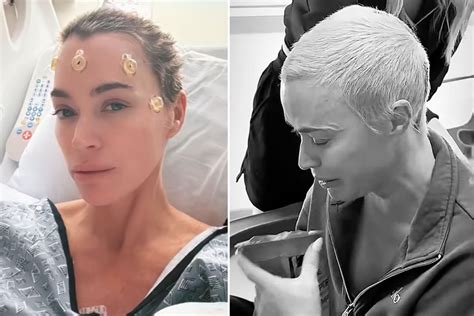
Teddi Mellencamp Arroyave, reality television personality and health advocate, recently shared an update on her health, revealing the return of headaches that prompted her to seek medical attention. The former “Real Housewives of Beverly Hills” star, who has been transparent about her previous health challenges, took to social media to keep her followers informed about her current situation and the steps she’s taking to address the issue.
Arroyave initially experienced severe vertigo, leading to concerns about a possible stroke. After undergoing thorough medical evaluations, including an MRI and CT scan, doctors ruled out a stroke and determined that the vertigo was likely caused by a malfunctioning ear crystal. However, her recent announcement indicates that she is now grappling with persistent headaches, prompting further investigation to determine the underlying cause.
“Back to getting some testing done,” Mellencamp Arroyave shared on her Instagram Stories. “I have been having severe headaches for the last few days.” She expressed her determination to identify the cause and find a solution. This health update comes after her previous health scares, including a battle with melanoma and her experience with vertigo, highlighting her commitment to proactively managing her well-being and sharing her journey with her followers.
Navigating Health Challenges: A Detailed Look
Teddi Mellencamp Arroyave has become known not only for her reality television appearances but also for her openness about her health struggles. By sharing her experiences, she has fostered a community of support and raised awareness about important health issues. Her recent health update regarding the return of headaches underscores the ongoing nature of health management and the importance of seeking medical attention when symptoms arise.
The initial concern over vertigo and the subsequent testing illustrate the diagnostic process involved in identifying the root cause of medical symptoms. While the initial tests ruled out a stroke, the determination that a malfunctioning ear crystal was the likely cause provided a temporary resolution. However, the recurrence of headaches suggests that there may be an underlying issue that requires further investigation.
Mellencamp Arroyave’s decision to undergo further testing demonstrates a proactive approach to health management. By seeking medical attention and pursuing diagnostic evaluations, she is taking steps to identify the cause of her headaches and explore potential treatment options. Her willingness to share her journey with her followers provides valuable insights into the challenges and complexities of navigating health issues.
Background: Mellencamp’s Previous Health Experiences
Teddi Mellencamp Arroyave’s health journey has been marked by several significant experiences. Her battle with melanoma, a type of skin cancer, brought awareness to the importance of early detection and sun protection. She has openly discussed her diagnosis, treatment, and recovery, emphasizing the need for regular skin checks and vigilance in protecting oneself from harmful UV rays.
In addition to her experience with melanoma, Mellencamp Arroyave has also shared her struggles with fertility and her journey through IVF (in vitro fertilization) to conceive her children. Her openness about these personal experiences has resonated with many individuals and couples facing similar challenges, fostering a sense of community and support.
The recent episode of vertigo, which initially raised concerns about a possible stroke, further underscores the importance of seeking prompt medical attention when experiencing new or unusual symptoms. While the tests ultimately ruled out a stroke, the experience served as a reminder of the potential seriousness of certain medical conditions and the need for timely diagnosis and treatment.
The Diagnostic Process: Vertigo and Headaches
The diagnostic process that Mellencamp Arroyave underwent highlights the steps involved in evaluating medical symptoms and identifying the underlying cause. When she initially experienced severe vertigo, doctors ordered an MRI (magnetic resonance imaging) and a CT scan (computed tomography) to rule out a stroke. These imaging tests provide detailed views of the brain and blood vessels, allowing doctors to assess for any abnormalities that could indicate a stroke.
In Mellencamp Arroyave’s case, the MRI and CT scan came back clear, ruling out a stroke as the cause of her vertigo. Doctors then determined that the vertigo was likely caused by a malfunctioning ear crystal. Vertigo is often associated with problems in the inner ear, which plays a crucial role in maintaining balance. Ear crystals, also known as otoliths, are small calcium carbonate crystals located in the inner ear. When these crystals become dislodged, they can disrupt the normal functioning of the inner ear and lead to vertigo.
The fact that Mellencamp Arroyave is now experiencing persistent headaches suggests that there may be a separate or additional underlying issue that needs to be addressed. Headaches can be caused by a wide range of factors, including tension, stress, dehydration, sinus infections, and more serious conditions such as migraines or brain tumors. The specific characteristics of the headaches, such as their location, intensity, and associated symptoms, can provide clues as to the underlying cause.
Exploring Potential Causes of Headaches
Given that Mellencamp Arroyave is experiencing persistent headaches, it is important to consider the potential causes and diagnostic steps that may be involved in determining the underlying issue. Some common causes of headaches include:
-
Tension headaches: These are the most common type of headache and are often associated with stress, muscle tension, and poor posture. Tension headaches typically cause a mild to moderate ache or pressure around the head, and they are not usually accompanied by other symptoms such as nausea or vomiting.
-
Migraines: Migraines are characterized by intense throbbing pain, usually on one side of the head. They are often accompanied by other symptoms such as nausea, vomiting, and sensitivity to light and sound. Migraines can be triggered by a variety of factors, including stress, hormonal changes, certain foods, and environmental factors.
-
Sinus headaches: These headaches are caused by inflammation or infection of the sinuses. They typically cause pain and pressure in the face, particularly around the eyes, cheeks, and forehead. Sinus headaches are often accompanied by other symptoms such as nasal congestion, runny nose, and fever.
-
Dehydration headaches: Dehydration can lead to headaches due to the reduction in blood volume and the subsequent decrease in oxygen supply to the brain. Dehydration headaches are often relieved by drinking fluids.
-
Cervicogenic headaches: These headaches originate from problems in the neck, such as muscle tension, arthritis, or nerve compression. Cervicogenic headaches typically cause pain that radiates from the neck to the head, and they may be accompanied by neck stiffness or limited range of motion.
-
Cluster headaches: Cluster headaches are severe headaches that occur in clusters, with multiple headaches occurring over a period of days or weeks. They are often accompanied by other symptoms such as eye tearing, nasal congestion, and facial sweating.
-
Brain tumors: In rare cases, headaches can be a symptom of a brain tumor. Brain tumor headaches are often persistent and progressively worsen over time. They may be accompanied by other neurological symptoms such as seizures, weakness, or changes in vision or speech.
Diagnostic Tests for Headaches
To determine the underlying cause of Mellencamp Arroyave’s headaches, doctors may recommend a variety of diagnostic tests. These tests can help to rule out certain conditions and identify any structural or functional abnormalities that may be contributing to the headaches. Some common diagnostic tests for headaches include:
-
Neurological examination: A neurological examination involves assessing a patient’s reflexes, muscle strength, coordination, sensation, and mental status. This examination can help to identify any neurological deficits that may be associated with the headaches.
-
Blood tests: Blood tests can be used to check for signs of infection, inflammation, or other underlying medical conditions that may be contributing to the headaches.
-
MRI (magnetic resonance imaging): An MRI scan uses strong magnetic fields and radio waves to create detailed images of the brain and surrounding tissues. MRI scans can help to detect structural abnormalities such as brain tumors, aneurysms, or lesions.
-
CT scan (computed tomography): A CT scan uses X-rays to create cross-sectional images of the brain and surrounding tissues. CT scans can help to detect fractures, bleeding, or other abnormalities.
-
Spinal tap (lumbar puncture): A spinal tap involves inserting a needle into the lower back to collect a sample of cerebrospinal fluid (CSF). CSF is the fluid that surrounds the brain and spinal cord. Analyzing CSF can help to detect infections, inflammation, or other abnormalities.
-
Electroencephalogram (EEG): An EEG measures the electrical activity of the brain using electrodes placed on the scalp. EEG can help to detect seizures or other abnormal brain activity.
Mellencamp’s Transparency and Impact
Teddi Mellencamp Arroyave’s decision to share her health experiences with her followers is commendable. By being open and transparent about her challenges, she has created a platform for discussion and support. Her willingness to share her journey with melanoma, fertility struggles, vertigo, and now headaches has resonated with many individuals who may be facing similar health issues.
Mellencamp Arroyave’s transparency has helped to break down stigmas surrounding health issues and encourage others to seek medical attention when needed. By sharing her experiences, she has empowered others to take control of their health and advocate for their well-being. Her efforts to raise awareness about melanoma, in particular, have likely saved lives by encouraging people to get regular skin checks and protect themselves from harmful UV rays.
The Role of Social Media in Health Advocacy
Social media has become an increasingly important tool for health advocacy and awareness. Individuals like Teddi Mellencamp Arroyave are using social media platforms to share their health experiences, educate others about health issues, and connect with communities of support. Social media can be a powerful way to reach a large audience and raise awareness about important health topics.
However, it is important to note that social media should not be used as a substitute for medical advice. While social media can provide valuable information and support, it is essential to consult with a qualified healthcare professional for diagnosis and treatment. It is also important to be critical of the information shared on social media and to verify information from reputable sources.
Maintaining a Healthy Lifestyle
In addition to seeking medical attention when needed, maintaining a healthy lifestyle is crucial for overall well-being. Some key aspects of a healthy lifestyle include:
-
Eating a balanced diet: A balanced diet provides the body with the nutrients it needs to function properly. A healthy diet should include a variety of fruits, vegetables, whole grains, lean proteins, and healthy fats.
-
Getting regular exercise: Regular exercise has numerous health benefits, including reducing the risk of chronic diseases, improving mood, and boosting energy levels. Aim for at least 150 minutes of moderate-intensity exercise or 75 minutes of vigorous-intensity exercise per week.
-
Getting enough sleep: Sleep is essential for physical and mental health. Most adults need around 7-8 hours of sleep per night.
-
Managing stress: Chronic stress can have a negative impact on health. Find healthy ways to manage stress, such as exercise, meditation, or spending time in nature.
-
Avoiding tobacco and excessive alcohol consumption: Tobacco use and excessive alcohol consumption are harmful to health and can increase the risk of chronic diseases.
The Importance of Seeking Medical Advice
Teddi Mellencamp Arroyave’s health update serves as a reminder of the importance of seeking medical advice when experiencing new or unusual symptoms. Headaches, in particular, can be a sign of a wide range of underlying medical conditions, some of which can be serious. It is important to consult with a doctor to determine the cause of headaches and to receive appropriate treatment.
By seeking medical attention and undergoing diagnostic testing, Mellencamp Arroyave is taking proactive steps to protect her health. Her willingness to share her journey with her followers provides valuable insights into the importance of health awareness and self-advocacy.
Conclusion
Teddi Mellencamp Arroyave’s recent health update regarding the return of headaches highlights the ongoing nature of health management and the importance of seeking medical attention when symptoms arise. Her transparency in sharing her health experiences has made her a health advocate, creating a platform for discussion and support. Her openness about her challenges has resonated with many individuals who may be facing similar health issues. As she continues to undergo testing and seek solutions for her headaches, her commitment to proactively managing her well-being serves as an inspiration for others to prioritize their health. Mellencamp Arroyave’s story emphasizes the need for early detection, regular check-ups, and open communication with healthcare providers to ensure a healthy life.
Frequently Asked Questions (FAQ)
1. What prompted Teddi Mellencamp to seek medical attention recently?
Teddi Mellencamp sought medical attention due to the return of severe headaches that she had been experiencing for several days. This followed a previous health scare involving vertigo.
2. What were the initial concerns when Teddi experienced vertigo?
Initially, doctors were concerned that the vertigo might be a sign of a stroke. She underwent an MRI and CT scan to rule out this possibility.
3. What was the diagnosed cause of Teddi’s vertigo?
After the MRI and CT scan ruled out a stroke, doctors determined that the vertigo was likely caused by a malfunctioning ear crystal (otolith).
4. What kind of health issues has Teddi Mellencamp publicly discussed in the past?
Teddi Mellencamp has been open about her experiences with melanoma (skin cancer), fertility struggles (including IVF), and her recent episode of vertigo.
5. Why is Teddi Mellencamp’s decision to share her health updates considered significant?
Teddi’s transparency is significant because it raises awareness about various health issues, encourages others to seek medical attention when needed, and fosters a sense of community and support among her followers who may be facing similar challenges. Her openness helps to break down stigmas associated with health problems.









